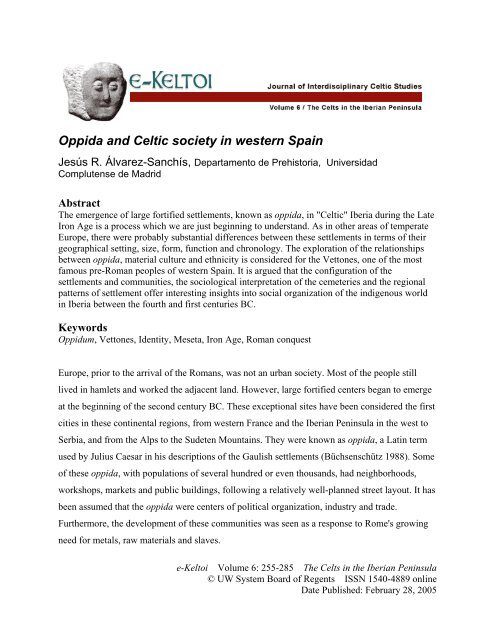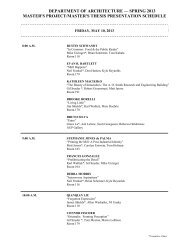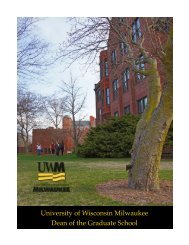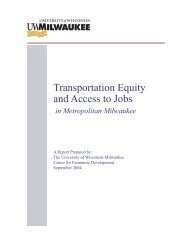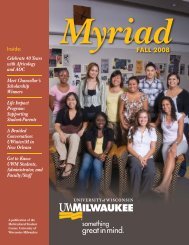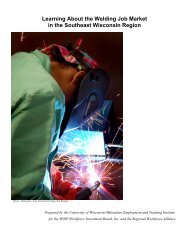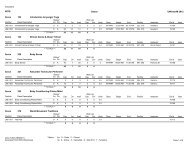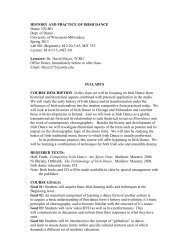Oppida and Celtic society in western Spain
Oppida and Celtic society in western Spain
Oppida and Celtic society in western Spain
Create successful ePaper yourself
Turn your PDF publications into a flip-book with our unique Google optimized e-Paper software.
<strong>Oppida</strong> <strong>and</strong> <strong>Celtic</strong> <strong>society</strong> <strong>in</strong> <strong>western</strong> Spa<strong>in</strong><br />
Jesús R. Álvarez-Sanchís, Departamento de Prehistoria, Universidad<br />
Complutense de Madrid<br />
Abstract<br />
The emergence of large fortified settlements, known as oppida, <strong>in</strong> "<strong>Celtic</strong>" Iberia dur<strong>in</strong>g the Late<br />
Iron Age is a process which we are just beg<strong>in</strong>n<strong>in</strong>g to underst<strong>and</strong>. As <strong>in</strong> other areas of temperate<br />
Europe, there were probably substantial differences between these settlements <strong>in</strong> terms of their<br />
geographical sett<strong>in</strong>g, size, form, function <strong>and</strong> chronology. The exploration of the relationships<br />
between oppida, material culture <strong>and</strong> ethnicity is considered for the Vettones, one of the most<br />
famous pre-Roman peoples of <strong>western</strong> Spa<strong>in</strong>. It is argued that the configuration of the<br />
settlements <strong>and</strong> communities, the sociological <strong>in</strong>terpretation of the cemeteries <strong>and</strong> the regional<br />
patterns of settlement offer <strong>in</strong>terest<strong>in</strong>g <strong>in</strong>sights <strong>in</strong>to social organization of the <strong>in</strong>digenous world<br />
<strong>in</strong> Iberia between the fourth <strong>and</strong> first centuries BC.<br />
Keywords<br />
Oppidum, Vettones, Identity, Meseta, Iron Age, Roman conquest<br />
Europe, prior to the arrival of the Romans, was not an urban <strong>society</strong>. Most of the people still<br />
lived <strong>in</strong> hamlets <strong>and</strong> worked the adjacent l<strong>and</strong>. However, large fortified centers began to emerge<br />
at the beg<strong>in</strong>n<strong>in</strong>g of the second century BC. These exceptional sites have been considered the first<br />
cities <strong>in</strong> these cont<strong>in</strong>ental regions, from <strong>western</strong> France <strong>and</strong> the Iberian Pen<strong>in</strong>sula <strong>in</strong> the west to<br />
Serbia, <strong>and</strong> from the Alps to the Sudeten Mounta<strong>in</strong>s. They were known as oppida, a Lat<strong>in</strong> term<br />
used by Julius Caesar <strong>in</strong> his descriptions of the Gaulish settlements (Büchsenschütz 1988). Some<br />
of these oppida, with populations of several hundred or even thous<strong>and</strong>s, had neighborhoods,<br />
workshops, markets <strong>and</strong> public build<strong>in</strong>gs, follow<strong>in</strong>g a relatively well-planned street layout. It has<br />
been assumed that the oppida were centers of political organization, <strong>in</strong>dustry <strong>and</strong> trade.<br />
Furthermore, the development of these communities was seen as a response to Rome's grow<strong>in</strong>g<br />
need for metals, raw materials <strong>and</strong> slaves.<br />
e-Keltoi Volume 6: 255-285 The Celts <strong>in</strong> the Iberian Pen<strong>in</strong>sula<br />
© UW System Board of Regents ISSN 1540-4889 onl<strong>in</strong>e<br />
Date Published: February 28, 2005
256 Álvarez-Sanchís<br />
We know that <strong>in</strong> this period a considerable part of what is now Spa<strong>in</strong> was <strong>in</strong>tensely exploited <strong>and</strong><br />
that large expanses of woodl<strong>and</strong> were be<strong>in</strong>g cleared for graz<strong>in</strong>g l<strong>and</strong> <strong>and</strong> cultivation. These<br />
strategies enabled people to rema<strong>in</strong> for longer periods <strong>in</strong> the same place, made longer-last<strong>in</strong>g <strong>and</strong><br />
larger settlements possible, led to a noteworthy population <strong>in</strong>crease <strong>and</strong> produced marked signs<br />
of social stratification (Ruiz-Gálvez 1991, 1998). It was also a period <strong>in</strong> which the population<br />
systematically protected itself aga<strong>in</strong>st war by build<strong>in</strong>g walls, towers <strong>and</strong> ditches, fortifications<br />
that were common <strong>in</strong> many regions. We know very little about how much <strong>in</strong>ter-oppida contact<br />
took place at that time, but the communities of the <strong>western</strong> Meseta, that is, the territory where the<br />
prov<strong>in</strong>ces of Avila <strong>and</strong> Salamanca are today as well as parts of Zamora, Toledo <strong>and</strong> Cáceres<br />
(Fig. 1), certa<strong>in</strong>ly shared a number of features - social <strong>and</strong> economic organization, material<br />
elements, language, <strong>and</strong> probably also ideas <strong>and</strong> religious beliefs - to the extent that these shared<br />
characteristics were recognized by the Roman authors <strong>and</strong> given the name of Vettonia or region<br />
of the Vetton peoples (Álvarez-Sanchís 1999; Sánchez Moreno 2000).<br />
Figure 1. Map of <strong>western</strong> <strong>and</strong> central Iberia show<strong>in</strong>g the location of the Iron Age <strong>and</strong> Roman Republican<br />
sites cited <strong>in</strong> the text, <strong>and</strong> the nucleus of the Vettonian Culture with the names of the pr<strong>in</strong>cipal <strong>Celtic</strong> tribes -<br />
<strong>in</strong> larger capitals - accord<strong>in</strong>g to written sources (After Álvarez-Sanchís 2000).
<strong>Oppida</strong> <strong>and</strong> <strong>Celtic</strong> <strong>society</strong> <strong>in</strong> <strong>western</strong> Spa<strong>in</strong> 257<br />
That Iron Age world was the demographic base from which the oppida emerged. Among<br />
other reasons, this subject is of great <strong>in</strong>terest, s<strong>in</strong>ce the growth of these centers co<strong>in</strong>cided with the<br />
first complex organization of the territory. However, does that mean that there were no Vetton<br />
cities before this time? We know when some small settlements were founded, but the evolution<br />
of these communities <strong>in</strong>to others that were somewhat larger <strong>and</strong> more complex is not clear. A<br />
basic question is whether these cities grew <strong>in</strong> response to an <strong>in</strong>ternal process of evolution or to a<br />
changed model of <strong>society</strong> imposed by Rome. Were the Vetton cities founded at the time of the<br />
Roman conquest (second to first centuries BC), or were they the outcome of the long-term<br />
growth of small farms <strong>and</strong> hamlets, <strong>and</strong> the capacity of some of these communities to control a<br />
larger <strong>and</strong> more hierarchical territory?<br />
Between the end of the sixth century BC <strong>and</strong> the fourth century BC, the system of<br />
settlement evolved towards more complex forms (Ruiz Zapatero <strong>and</strong> Lorrio 1999; Álvarez-<br />
Sanchís 2000). The most important phenomenon was the emergence of new fortified villages that<br />
spread over much of the Meseta. Their <strong>in</strong>habitants were buried <strong>in</strong> cremation cemeteries <strong>and</strong> were<br />
accompanied by grave goods that <strong>in</strong>cluded a small but significant percentage of iron weapons<br />
(Ruiz Zapatero <strong>and</strong> Lorrio 1995). These fortified villages dom<strong>in</strong>ated the settlement pattern of this<br />
period until the systems of settlement broke up after the Roman conquest. It is difficult to know<br />
whether the custom of cremat<strong>in</strong>g the dead spread from displaced populations that arrived from<br />
the high ranges of the eastern Meseta, the nucleus of the Celtiberian people where the oldest<br />
cemeteries are located, or if it was simply the result of a process of acculturation (Almagro-<br />
Gorbea 1993, 2001; Lorrio 1997). In any event, the <strong>in</strong>fluence of the peoples who spoke <strong>Celtic</strong><br />
languages over the rema<strong>in</strong><strong>in</strong>g groups is undeniable (de Hoz 1993).<br />
The process of transformation of these communities <strong>in</strong>to more complex ones still raises a<br />
number of questions (Collis 1984, 1995; Cunliffe 1994, 1997, 1998). Not all the oppida were<br />
founded at the time of the Roman conquest. The Classical sources mention the existence of large<br />
<strong>in</strong>digenous towns <strong>in</strong> the second century BC, <strong>and</strong> this gives us a term<strong>in</strong>us antequem for their<br />
construction (Almagro-Gorbea <strong>and</strong> Lorrio 1991). Thus, it is possible to trace their orig<strong>in</strong>s to an<br />
earlier date. The archaeological evidence demonstrates the existence of settlements that were<br />
already important centers <strong>in</strong> the fourth <strong>and</strong> third centuries BC, which means that <strong>in</strong>ter-regional<br />
trade had already become established <strong>in</strong> this period.<br />
A number of scholars have emphasized the urban character of these settlements by
258 Álvarez-Sanchís<br />
search<strong>in</strong>g the oppida for typical elements of Mediterranean cities: a regular street layout,<br />
monumental build<strong>in</strong>gs, public fora, etc. However, they have failed to bear <strong>in</strong> m<strong>in</strong>d that, as <strong>in</strong> the<br />
Mediterranean, a different ideological concept of "city" might have existed <strong>in</strong> this culture (Woolf<br />
1993). Recogniz<strong>in</strong>g the <strong>in</strong>ternal organization of these centers <strong>and</strong> evaluat<strong>in</strong>g to what extent the<br />
resources of a territory might have conditioned their patterns of distribution <strong>and</strong> specialization<br />
can tell us much about the k<strong>in</strong>d of <strong>society</strong> that lived <strong>in</strong> the oppida, <strong>and</strong> whether the <strong>society</strong> was<br />
urbanized or not. We shall start with an evaluation of the evidence that is currently available.<br />
Towards the formation of the oppida (400-200 BC): the <strong>in</strong>ternal stimuli<br />
The most archaic rema<strong>in</strong>s <strong>in</strong> Salamanca are found on a hill near the Tormes River. At the<br />
beg<strong>in</strong>n<strong>in</strong>g of the Iron Age, a settlement cover<strong>in</strong>g 1.5 hectares existed there. However, by the<br />
third century BC the <strong>in</strong>habitated area had spread to the neighbour<strong>in</strong>g hill, as the f<strong>in</strong>ds of<br />
decorated pottery <strong>and</strong> several iron objects attest; the settlement had grown by then to an area of<br />
around 20 hectares (Martín Valls et al. 1991). We know that the city was conquered by Hannibal<br />
the Carthag<strong>in</strong>ian <strong>in</strong> the spr<strong>in</strong>g of 220 BC. The Classical sources refer to this event on various<br />
occasions <strong>and</strong> a number of commentaries deserve attention. Initially, this settlement is described<br />
as a "large city" or a "large city <strong>in</strong> Iberia" (Polyaenus, 7, 48; Plutarch, mul. uirt.); then the<br />
situation dur<strong>in</strong>g its conquest is mentioned, <strong>in</strong> particular Plutarch's reference to a district separated<br />
from the ma<strong>in</strong> center, which suggests it was a large <strong>and</strong> differentiated site; <strong>and</strong> f<strong>in</strong>ally, Livy's<br />
reference (21, 5) <strong>in</strong> which he reports that the city was taken by assault <strong>and</strong> that the whole site<br />
was fortified. This is partially borne out by the fact that on one of the hills the foundations of a<br />
wall built of large blocks of granite have been found (Martín Valls 1999: 215) that supported an<br />
archaeological deposit with materials dated to the third <strong>and</strong> second centuries BC.<br />
It is likely that by that time some settlements <strong>in</strong> the prov<strong>in</strong>ce of Ávila were undergo<strong>in</strong>g<br />
considerable reconstruction. La Mesa de Mir<strong>and</strong>a (Chamartín de la Sierra) is an oppidum<br />
consist<strong>in</strong>g of three walled enclosures that cover an area of 30 hectares (Figs. 2, 3). The first two<br />
(19 hectares), with ditches <strong>and</strong> chevaux-de-frise <strong>in</strong> front of the entrances, were <strong>in</strong>terpreted as<br />
residential areas (Cabré et al. 1950: 15-17), but it must be admitted that most of the rema<strong>in</strong>s are<br />
known from the first enclosure. The third part of the site was re<strong>in</strong>forced with large square towers.<br />
However, the build<strong>in</strong>gs have practically no foundations, someth<strong>in</strong>g that suggests that the<br />
settlement was more than just an agglomeration of houses <strong>and</strong> stables. In keep<strong>in</strong>g with the
<strong>Oppida</strong> <strong>and</strong> <strong>Celtic</strong> <strong>society</strong> <strong>in</strong> <strong>western</strong> Spa<strong>in</strong> 259<br />
Figure 2. Plan of the oppidum of la Mesa de Mir<strong>and</strong>a, Chamartín de la Sierra, Ávila, <strong>and</strong> phases of occupation. The last rampart was<br />
protected with stone walls <strong>and</strong> towers based on Mediterranean models. Fourth to late second centuries BC. (After Álvarez-Sanchís<br />
1999).
260 Álvarez-Sanchís<br />
chronology furnished by the grave<br />
goods from the associated cemetery, the<br />
first two enclosures were built <strong>in</strong> the<br />
course of the fourth <strong>and</strong> third centuries<br />
BC. The third enclosure disturbed part<br />
of the cemetery, <strong>and</strong> is associated with<br />
the wars of the Roman conquest.<br />
Las Cogotas (Cardeñosa) is<br />
another large site (15 hectares),<br />
Figure 3. A barrier of closely spaced angular rocks placed to h<strong>in</strong>der the<br />
defended by two walled enclosures approach of men or horses to the oppidum of La Mesa de Mir<strong>and</strong>a,<br />
Ávila. This defensive device known as chevaux-de-frise is found <strong>in</strong><br />
(Cabré 1930). The last excavations <strong>western</strong> Europe from the Iberian Pen<strong>in</strong>sula to the British Isles (Photo:<br />
J.R. Álvarez-Sanchís).<br />
carried out <strong>in</strong> the southwest of the<br />
second enclosure (Ruiz Zapatero <strong>and</strong> Álvarez-Sanchís 1995) have revealed an area with<br />
abundant archaeological material <strong>and</strong> various specialized areas; a large communal midden, a<br />
stone pavement of complex <strong>in</strong>terpretation connected with the fortification wall, <strong>and</strong> a potter's<br />
workshop (Figs. 4, 5). The wheel-made pots with pa<strong>in</strong>ted decoration found at the site are dated to<br />
the second century BC. The observed stratigraphy is also important: the existence of a midden<br />
under the wall demonstrates that before the potter's workshop <strong>and</strong> the fortifications were built,<br />
artisanal activities were already be<strong>in</strong>g carried out <strong>in</strong> this area. Thus, <strong>in</strong> the sequence of the<br />
oppidum's occupation, there was an early period (fourth to third centuries BC) when only the<br />
upper part was walled <strong>and</strong> secondary<br />
activities were carried out <strong>in</strong> a flat area<br />
occupied by a poor quarter to the<br />
southwest, followed by a second period<br />
(second century BC) when it was<br />
decided to build a wall around this<br />
sector. It is thus <strong>in</strong>terest<strong>in</strong>g to observe<br />
that a decision was taken to establish a<br />
series of specialized activity areas <strong>and</strong><br />
Figure 4. The oppidum of Las Cogotas, Cardeñosa, Ávila was first<br />
<strong>in</strong>clude them with<strong>in</strong> the city's<br />
occupied <strong>in</strong> the Late Bronze Age but was first fortified <strong>in</strong> the fourth<br />
century BC. It was defended with stone walls <strong>and</strong> bastions beside the<br />
boundaries.<br />
ma<strong>in</strong> gates (Photo: J.R. Álvarez-Sanchís).
<strong>Oppida</strong> <strong>and</strong> <strong>Celtic</strong> <strong>society</strong> <strong>in</strong> <strong>western</strong> Spa<strong>in</strong> 261<br />
Figure 5. Plan of the oppidum of Las Cogotas, Ávila. Internal structure, plan of the houses beside the ma<strong>in</strong> gate <strong>and</strong> an attempted<br />
reconstruction. The histogram <strong>in</strong>dicates surface areas with<strong>in</strong> the houses (After Ruiz Zapatero <strong>and</strong> Álvarez-Sanchís 1995).
262 Álvarez-Sanchís<br />
From the fourth century BC onwards, these <strong>and</strong> other settlements provide evidence of<br />
agricultural <strong>and</strong> <strong>in</strong>dustrial production that demonstrates that manufactur<strong>in</strong>g <strong>and</strong> food production<br />
had reached unprecedented levels (Martín Valls <strong>and</strong> Esparza 1992; Álvarez-Sanchís 2003). Interregional<br />
trade would have played a very important role <strong>in</strong> this <strong>in</strong>tensification, expla<strong>in</strong><strong>in</strong>g the<br />
transportation of products over great distances <strong>and</strong> the presence of specialized workers. The<br />
grave goods recovered from the Vetton cemeteries of Las Cogotas (Cabré 1932), El Raso<br />
(Fernández Gómez 1986, 1997), La Mesa de Mir<strong>and</strong>a (Cabré et al. 1950) <strong>and</strong> Alcántara (Esteban<br />
Ortega et al. 1988) have provided various types of swords, spears <strong>and</strong> daggers of iron as well as<br />
shields, fibulae, belt buckles, bronze cauldrons, Greek ceramics, Campanian ceramics <strong>and</strong> other<br />
vessels, which demonstrate the existence of close contact with eastern <strong>and</strong> southern Spa<strong>in</strong>. The<br />
production <strong>and</strong> exchange of manufactured goods became quite complex <strong>and</strong>, although the<br />
available evidence does not permit this to be confirmed, there are signs that suggest that basic<br />
food production <strong>in</strong>creased considerably at this time (Esparza 1999; Ruiz Zapatero 1999).<br />
Obta<strong>in</strong><strong>in</strong>g a food surplus <strong>in</strong> order to penetrate the trad<strong>in</strong>g networks would have led to an<br />
expansion of agriculture <strong>and</strong> stock rais<strong>in</strong>g. This surplus would also have encouraged production<br />
<strong>in</strong> the workshops of the oppida <strong>and</strong> some degree of specialization. Let us look at some examples.<br />
In the prov<strong>in</strong>ce of Ávila, the fortified towns appear to occupy the p<strong>in</strong>nacle of a<br />
hierarchical settlement pattern, followed by a second tier of small hamlets <strong>and</strong> isolated farms.<br />
The latter were generally located <strong>in</strong> the vic<strong>in</strong>ity of rivers, were not fortified <strong>and</strong> have produced<br />
evidence <strong>in</strong>dicat<strong>in</strong>g that their <strong>in</strong>habitants must have spent most of their time farm<strong>in</strong>g. We do not<br />
know much about these small sites. They were the most numerous type of settlement <strong>and</strong> would<br />
have accounted for a good part of the rural population's structure. However, as <strong>in</strong> many other<br />
contexts, sites <strong>in</strong> this category have rarely been excavated <strong>and</strong> the archaeologists' efforts <strong>and</strong><br />
<strong>in</strong>terest have been directed at the larger sites because they are more worthwhile <strong>in</strong> terms of<br />
research. In some cases, as <strong>in</strong> the Amblés valley, they differed from the oppida <strong>in</strong> two ways<br />
(Álvarez-Sanchís 1999: 115 ff.). Firstly, they differed <strong>in</strong> terms of the l<strong>and</strong> worked. The small<br />
sites reveal a strong agricultural component s<strong>in</strong>ce they are located on the valley floors that<br />
generally have rich alluvial soils, whereas the oppida apparently tended more to stock rais<strong>in</strong>g,<br />
based on the topography <strong>and</strong> the quality of the soils <strong>in</strong> their vic<strong>in</strong>ity. Secondly, the functions of<br />
the oppida <strong>and</strong> the small settlements were different. The oppida acquired their <strong>in</strong>dividual<br />
character because they developed <strong>in</strong>dustrial activities - well-documented <strong>in</strong> the potter's workshop
of Las Cogotas, for example; they were<br />
<strong>in</strong>volved <strong>in</strong> trad<strong>in</strong>g networks, as<br />
evidenced by the weapons found <strong>in</strong> the<br />
cemeteries <strong>and</strong> some imports; they<br />
were strongly fortified; <strong>and</strong> they<br />
erected monuments that had a religious<br />
function.<br />
The oppidum of Ulaca<br />
(Solosancho, Ávila), the largest of the<br />
Vetton oppida (70 hectares) <strong>and</strong> one of<br />
the best known <strong>in</strong> <strong>Celtic</strong> Iberia, is<br />
famous for the monumental character<br />
of some of its build<strong>in</strong>gs (Ruiz Zapatero<br />
<strong>and</strong> Álvarez-Sanchís 1999). Two large<br />
constructions st<strong>and</strong> out <strong>in</strong> the central<strong>western</strong><br />
sector of the settlement (Figs.<br />
6, 7, 8). The first is a large rectangular<br />
space (16 x 8 m) hewn out of a rock<br />
<strong>and</strong> associated with a large crag, <strong>in</strong><br />
which a double staircase leads to a<br />
platform with two hollows that are<br />
connected to each other. One of them<br />
comes out <strong>in</strong>to a third, which<br />
communicates <strong>in</strong> turn with the lower<br />
part of the crag through a channel. The<br />
monument has been <strong>in</strong>terpreted as<br />
hav<strong>in</strong>g a religious function because of<br />
its similarities with the Portuguese<br />
sanctuary of Panoias (Vila Real),<br />
which has Lat<strong>in</strong> <strong>in</strong>scriptions stat<strong>in</strong>g<br />
that animal sacrifices took place there<br />
<strong>Oppida</strong> <strong>and</strong> <strong>Celtic</strong> <strong>society</strong> <strong>in</strong> <strong>western</strong> Spa<strong>in</strong> 263<br />
Figure 6. The oppidum of Ulaca, Solosancho, Ávila dom<strong>in</strong>ates the<br />
surround<strong>in</strong>g countryside. It was probably the Vettones' ma<strong>in</strong> center <strong>in</strong><br />
west-central Spa<strong>in</strong> at the time of the Roman conquest of the Iberian<br />
Pen<strong>in</strong>sula (Photo: J.R. Álvarez-Sanchís).<br />
Figure 7. The sanctuary of Ulaca, Ávila, was used dur<strong>in</strong>g the Iron Age.<br />
Animal sacrifices took place there (Photo: J.R. Álvarez-Sanchís).<br />
Figure 8. Partial view of the sanctuary of Ulaca, Ávila, <strong>in</strong> which a<br />
double staircase leads to a platform with two hollows that are connected<br />
to each other (Photo: J.R. Álvarez-Sanchís).
264 Álvarez-Sanchís<br />
(Alföldy 1995; Rodríguez Colmenero 1999). Near the altar of Ulaca there is another structure <strong>in</strong><br />
the rock with a rectangular plan (6.4 m), divided <strong>in</strong>to three sections: ante-chamber, chamber <strong>and</strong><br />
oven. Its layout is similar to the saunas found <strong>in</strong> a number of settlements <strong>in</strong> the northwest of the<br />
Iberian Pen<strong>in</strong>sula (Silva 1986; Ríos González 2000). Strabo refers to these activities, which<br />
appear to be related to <strong>in</strong>itiation rites l<strong>in</strong>ked to warriors <strong>and</strong> bath<strong>in</strong>g (Almagro-Gorbea <strong>and</strong><br />
Álvarez-Sanchís 1993).<br />
It seems reasonable to suggest that Ulaca was the most important settlement <strong>in</strong> the region<br />
<strong>in</strong> view of the sanctuary, which must have served the whole area, <strong>and</strong> the size of the oppidum.<br />
These features contrast with what can be <strong>in</strong>ferred from what we know about the small<br />
settlements on the pla<strong>in</strong> where production output appears to have been limited <strong>and</strong> evidence for<br />
long-distant contacts <strong>and</strong> defensive or religious structures is absent.<br />
The Iron Age communities <strong>in</strong> the<br />
west of Salamanca are different. The sites<br />
are smaller, always fewer than ten hectares.<br />
Irueña (Fuentegu<strong>in</strong>aldo) has an area of n<strong>in</strong>e<br />
hectares, Las Merchanas (Lumbrales) <strong>and</strong><br />
Yecla (Yecla de Yeltes) nearly five, <strong>and</strong> El<br />
Picón de la Mora (Enc<strong>in</strong>asola de los<br />
Comendadores) a little over one hectare.<br />
Figure 9. The Vettonian hillfort of Yecla de Yeltes, Salamanca,<br />
The walls <strong>and</strong> other defences (ditches,<br />
probably constructed <strong>in</strong> the fifth century BC <strong>and</strong> defended with<br />
stone walls, bastions <strong>and</strong> chevaux-de-frise (Photo: J.R. Álvareztowers,<br />
chevaux-de-frise) are their most Sanchís).<br />
strik<strong>in</strong>g feature <strong>and</strong> this has given them a<br />
character of their own (Figs. 9, 10), which is<br />
generally lack<strong>in</strong>g <strong>in</strong> less important<br />
settlements such as farmsteads <strong>and</strong> hamlets.<br />
The most spectacular group is located on the<br />
Yeltes <strong>and</strong> Huebra Rivers; <strong>in</strong> a radius of<br />
fewer than 10 km there are six settlements<br />
of this type (Álvarez-Sanchís 1999: 120-<br />
126; Martín Valls 1999). The characteristics<br />
of the l<strong>and</strong> make it clear that these<br />
Figure 10. Carved stone walls from the Iron Age hillfort of Yecla<br />
de Yeltes, Salamanca. The image shows a group of men rid<strong>in</strong>g<br />
horses (Photo: J.R. Álvarez-Sanchís).
<strong>Oppida</strong> <strong>and</strong> <strong>Celtic</strong> <strong>society</strong> <strong>in</strong> <strong>western</strong> Spa<strong>in</strong> 265<br />
settlements were geared to livestock breed<strong>in</strong>g. There are also important iron, copper <strong>and</strong> t<strong>in</strong><br />
m<strong>in</strong>es <strong>in</strong> the surround<strong>in</strong>g area. There is no def<strong>in</strong>ite archaeological evidence that the m<strong>in</strong>es were<br />
exploited <strong>in</strong> the pre-Roman period, but it is tempt<strong>in</strong>g to l<strong>in</strong>k the development of these settlements<br />
with m<strong>in</strong><strong>in</strong>g (Sal<strong>in</strong>as 1992-93: 179-180).<br />
This diversity <strong>in</strong> the forms of settlement <strong>in</strong> the <strong>western</strong> Meseta would seem to express a<br />
wide range of social <strong>and</strong> economic organization types. The territories be<strong>in</strong>g worked by the<br />
oppida, the small rural farms, the specialized sites <strong>and</strong> their apparent activities <strong>and</strong> functions,<br />
clearly <strong>in</strong>dicate that there were considerable differences between their populations.<br />
How many people?<br />
The demography of the cemeteries <strong>and</strong> the extrapolation of these numbers to the<br />
settlements has been recently studied (Ruiz Zapatero <strong>and</strong> Álvarez-Sanchís 1995; Álvarez-<br />
Sanchís <strong>and</strong> Ruiz Zapatero 2001) under the assumption that the excavations of some Vetton<br />
cemeteries were fairly exhaustive <strong>and</strong> that we could reasonably assume that the number of tombs<br />
was very close to that of the burials of the period. By apply<strong>in</strong>g the Acsádi <strong>and</strong> Neméskeri (1970)<br />
formula it is feasible to calculate the population of Las Cogotas <strong>and</strong> La Mesa de Mir<strong>and</strong>a from<br />
the data provided by their cemeteries<br />
(1613 <strong>and</strong> 2230 tombs respectively). Las<br />
Cogotas was <strong>in</strong>habited by a community<br />
that must have oscillated between 200<br />
<strong>and</strong> 300 <strong>in</strong>habitants, while at La Mesa de<br />
Mir<strong>and</strong>a the necropolis appears to reflect<br />
a population of approximately 300 to 400<br />
<strong>in</strong>habitants.<br />
The population density per unit of<br />
area is another <strong>in</strong>terest<strong>in</strong>g piece of data<br />
(Fig. 11). We would be talk<strong>in</strong>g about<br />
approximately 15 <strong>in</strong>habitants per hectare<br />
<strong>in</strong> the first case, <strong>and</strong> about 20 <strong>in</strong>habitants<br />
Figure 11. Population density per unit of area <strong>in</strong> the oppida of Las<br />
per hectare <strong>in</strong> the second. At Ulaca we<br />
Cogotas <strong>and</strong> La Mesa de Mir<strong>and</strong>a (After Álvarez-Sanchís <strong>and</strong> Ruiz<br />
Zapatero 2001).<br />
know the surface area <strong>and</strong> the number of
266 Álvarez-Sanchís<br />
domestic structures, with 250 houses identified by <strong>in</strong>tensive survey (Ruiz Zapatero <strong>and</strong> Álvarez-<br />
Sanchís 1999). The above density of <strong>in</strong>habitants per hectare results <strong>in</strong> a total of between 1,050<br />
<strong>and</strong> 1,400 <strong>in</strong>habitants. However, the population could have <strong>in</strong>creased from time to time, for<br />
defensive reasons at times of social <strong>in</strong>stability or armed conflict, when the resident population<br />
could almost have doubled, particularly if we take <strong>in</strong>to account the ample space with<strong>in</strong> the<br />
settlement that shows no signs of occupation.<br />
We know very little about the structure of the regional population. For example, we do<br />
not know whether small farms close to the oppida buried their dead <strong>in</strong> the oppida cemeteries or<br />
had their own family necropoli that would be rather difficult to f<strong>in</strong>d now. In some cases there are<br />
traces of these farms but not of their tombs, <strong>and</strong> <strong>in</strong> many cases it must be assumed that neither<br />
the settlements nor the cemeteries have been detected due to a lack of <strong>in</strong>tensive surveys. We<br />
would probably be talk<strong>in</strong>g about hamlets of five or 10 houses. In any case, the population size of<br />
the Vetton communities, accord<strong>in</strong>g to the cemeteries <strong>and</strong> the size of the settlements, <strong>in</strong>dicates<br />
that some other important aspects were <strong>in</strong>volved besides demography: social organization, the<br />
subsistence economy or the cultural traditions of the people.<br />
Social spaces <strong>and</strong> symbolic spaces<br />
Vetton <strong>society</strong> <strong>in</strong> the fourth <strong>and</strong> third centuries BC was a stratified <strong>society</strong> led by an<br />
aristocratic elite that owned horses <strong>and</strong> sumptuous weapons that marked their position at the<br />
head of a larger group of warriors with a simpler panoply (Martín Valls 1986-87: 78; Álvarez-<br />
Sanchís 1999: 295 ff.). The weapons that have survived present different comb<strong>in</strong>ations that could<br />
reflect differences with<strong>in</strong> the military realm, from a small number of very rich tombs with<br />
complete panoplies that <strong>in</strong>cluded a sword, shield, a couple of spears <strong>and</strong> horse harnesses, to<br />
others that only conta<strong>in</strong>ed spears, that is, the basic equipment of light <strong>in</strong>fantry. A certa<strong>in</strong><br />
hierarchy can also be detected <strong>in</strong> the tombs that we would regard as female, a few of them<br />
hav<strong>in</strong>g rich items of adornment (bracelets, necklaces, fibulae, brooches) <strong>and</strong> others with much<br />
poorer grave goods. There are very few burials that can be attributed to men or women devoted<br />
to <strong>in</strong>dustrial work (metal work, pottery, tann<strong>in</strong>g, work with stone <strong>and</strong> wood, etc.), but skilled<br />
craftsmen certa<strong>in</strong>ly existed, as the tools found <strong>in</strong> domestic contexts of the oppida <strong>in</strong>dicate. Many<br />
farmers could have been part-time artisans, <strong>and</strong> a few may even have been engaged <strong>in</strong> small<br />
commercial ventures <strong>in</strong> the w<strong>in</strong>ter months. Ultimately, a reasonable estimate is that four out of
<strong>Oppida</strong> <strong>and</strong> <strong>Celtic</strong> <strong>society</strong> <strong>in</strong> <strong>western</strong> Spa<strong>in</strong> 267<br />
every five tombs conta<strong>in</strong>ed only ashes or a cremation urn; these would have belonged to humbler<br />
<strong>in</strong>dividuals <strong>and</strong> perhaps to servants or slaves, although this would be very difficult to prove<br />
(Balter 1995).<br />
An <strong>in</strong>terest<strong>in</strong>g feature of the organization of the Vetton cemeteries is the possibility of<br />
recogniz<strong>in</strong>g differentiated family groups (Castro 1986; Kurtz 1987). The existence of<br />
concentrations of tombs separated from each other by unoccupied areas, <strong>and</strong> of tombs with very<br />
rich grave goods <strong>and</strong> other poorer ones <strong>in</strong> each sector, could represent different clans with<strong>in</strong> the<br />
community that were buried separately to mark rights <strong>and</strong> obligations <strong>in</strong> a symbolic way. We<br />
could go further <strong>and</strong> relate the development of the oppida with important divisions <strong>in</strong> the<br />
l<strong>and</strong>scape that <strong>in</strong>clude these power relationships. The importance that specialized economies<br />
could have <strong>in</strong> some ethnic processes has been po<strong>in</strong>ted out (Burillo 1998: 139). Zoomorphic<br />
sculptures <strong>and</strong> decorative motifs used on pottery are, <strong>in</strong> this respect, very good <strong>in</strong>dicators for<br />
explor<strong>in</strong>g their use <strong>in</strong> the Iron Age. We know that a rather considerable number of the verracos,<br />
stone effigies of bulls, pigs <strong>and</strong> boars (more than 400 are known), which are found spread over<br />
the west of the Spanish Meseta <strong>and</strong> Portugal (Figs. 12, 13, 14), were sculpted between the mid-<br />
Figure 12. Map show<strong>in</strong>g the distribution of zoomorphic Iron Age sculptures known as "verracos" (After<br />
Álvarez-Sanchís 1999).
268 Álvarez-Sanchís<br />
fourth <strong>and</strong> first centuries BC. It was generally thought that<br />
these sculptures had religious significance related to the<br />
sacred protection of livestock, or were funerary monuments,<br />
because some of them bore Lat<strong>in</strong> <strong>in</strong>scriptions to that effect<br />
(Martín Valls 1974; Martín Valls <strong>and</strong> Pérez Herrero 1976).<br />
However, there are clear <strong>in</strong>dications that the best pastures<br />
<strong>in</strong> the valleys <strong>and</strong> nearby sources of water were marked <strong>in</strong><br />
the l<strong>and</strong>scape by the erection of these sculptures (Álvarez-<br />
Sanchís 1994 <strong>and</strong> 1999: 281-294). Many of them are very<br />
bulky. For <strong>in</strong>stance, the bulls of Villanueva <strong>and</strong> El Tiemblo<br />
<strong>in</strong> Ávila are over two meters long, weigh three to eight tons,<br />
<strong>and</strong> were placed <strong>in</strong> areas close to the settlements.<br />
Furthermore, these places have very high visibility over<br />
their surround<strong>in</strong>gs, that is, po<strong>in</strong>ts <strong>in</strong> the l<strong>and</strong>scape were<br />
deliberately chosen that would be easily identifiable<br />
(Álvarez-Sanchís <strong>and</strong> Ruiz Zapatero 1999). The verracos<br />
were an essential part of the Vetton l<strong>and</strong>scape, a form of<br />
organiz<strong>in</strong>g the l<strong>and</strong> <strong>in</strong> regions where there was a high<br />
density of population. At the same time, the sculptures<br />
symbolize the wealth of a stock rais<strong>in</strong>g community <strong>and</strong> the<br />
strength of certa<strong>in</strong> social groups, clearly attested, as we<br />
have seen, by the grave goods of the cemeteries.<br />
A scrut<strong>in</strong>y of decorative patterns can also be a good<br />
way of discover<strong>in</strong>g family traditions. In a straight l<strong>in</strong>e, the<br />
cemeteries of Las Cogotas <strong>and</strong> La Mesa de Mir<strong>and</strong>a are<br />
barely 20 km apart, but an exhaustive analysis of the<br />
<strong>in</strong>cised decoration of pottery deposited <strong>in</strong> the grave goods<br />
found there demonstrates very marked differences between<br />
them (Fig. 15). A few motifs are shared by both settlements<br />
- such as the typical <strong>in</strong>cised series of zig-zag rows, but the<br />
most important series of basketwork <strong>and</strong> corded patterns<br />
Figure 13. Vettonian sculptures of bulls,<br />
over 2.75 m. long <strong>and</strong> weigh<strong>in</strong>g six to eight<br />
tons each, generically known as "Toros de<br />
Guis<strong>and</strong>o", El Tiemblo, Ávila. Fourth to<br />
third centuries BC. (Photo: J.R. Álvarez-<br />
Sanchís).<br />
Figure 14. Sculpture of boar from the Iron<br />
Age hillfort of Yecla, Salamanca (Photo: A.<br />
Lorrio).
<strong>Oppida</strong> <strong>and</strong> <strong>Celtic</strong> <strong>society</strong> <strong>in</strong> <strong>western</strong> Spa<strong>in</strong> 269<br />
Figure 15. Diagram with a variation of motifs decorat<strong>in</strong>g the <strong>in</strong>cised pottery found <strong>in</strong> neighbour<strong>in</strong>g Vetton cemeteries. It shows<br />
marked differences at the settlement level (After Álvarez-Sanchís 1999).<br />
are almost exclusive either to one site or to the other. They probably replicate textile designs<br />
associated with other items of cloth<strong>in</strong>g or weapons, but the recovery of st<strong>and</strong>ardized decorative<br />
motifs undoubtedly reveals that some form of <strong>in</strong>tentional separation between cities that occupied<br />
the same valley existed (Álvarez-Sanchís 2000: 80, Fig. 11; Álvarez-Sanchís <strong>and</strong> Ruiz Zapatero<br />
2002). In other words, the stylistic identities displayed by the pottery must have been an<br />
expression of social identities, of communities that differentiated themselves <strong>and</strong> recognized one<br />
another as different, but that shared the same types of pottery <strong>and</strong> the same decorative<br />
techniques.<br />
The level of social <strong>and</strong> economic development reached would have led to conflict<br />
between neighbour<strong>in</strong>g communities. The proliferation of fortified settlements <strong>in</strong> this period fits<br />
fairly well with the panorama described. The reconstruction <strong>and</strong> rework<strong>in</strong>g of fortifications was<br />
common; these became more complex <strong>and</strong> reached their maximum expression <strong>in</strong> the second to<br />
first centuries BC (Martín Valls <strong>and</strong> Esparza 1992; Ruiz Zapatero 1999 <strong>and</strong> 2003). There is, as
270 Álvarez-Sanchís<br />
we have seen, extensive evidence of the importance of weapons, of the <strong>in</strong>dividual warrior <strong>and</strong> of<br />
his status <strong>in</strong> <strong>society</strong>. The military equipment <strong>in</strong> the Vetton cemeteries co<strong>in</strong>cides with the known<br />
record of the cemeteries of other peoples of the Iberian Península's <strong>in</strong>l<strong>and</strong> areas, such as the<br />
Lusitanians (Martín Bravo 1999), the Vaccaei (Sanz 1998) <strong>and</strong> the Celtiberians (Lorrio 1994).<br />
This suggests to some extent that the different elites of the Meseta were <strong>in</strong> contact with each<br />
other, <strong>and</strong> <strong>in</strong>dicates the existence of a shared warrior identity (Fig. 16). The subsequent conflict<br />
with Rome played a fundamental role <strong>in</strong> the development of this warrior <strong>society</strong>.<br />
Figure 16. Grave goods of Vetton cemeteries known <strong>in</strong> Ávila prov<strong>in</strong>ce. The types of vessels <strong>and</strong> weapons used <strong>in</strong> the Late Iron Age<br />
suggest the existence of two phases <strong>in</strong> their development (After Álvarez-Sanchís 2000).<br />
Towards the formation of the oppida (200-50 BC): external stimuli<br />
Many archaeologists cont<strong>in</strong>ue to th<strong>in</strong>k of the Roman conquest of most of Europe,<br />
<strong>in</strong>clud<strong>in</strong>g the Iberian Pen<strong>in</strong>sula, as an isolated factor <strong>in</strong>dependent of the development of<br />
prehistoric societies. Traditionally, prehistoric <strong>and</strong> temperate Europe on one h<strong>and</strong>, <strong>and</strong> Roman<br />
culture <strong>and</strong> history on the other, have tended to be studied as two entirely separate discipl<strong>in</strong>es
<strong>Oppida</strong> <strong>and</strong> <strong>Celtic</strong> <strong>society</strong> <strong>in</strong> <strong>western</strong> Spa<strong>in</strong> 271<br />
(Wells 1999 <strong>and</strong> 2002: 379). However, the study of the Iron Age peoples ought to be carried out<br />
by develop<strong>in</strong>g a completely <strong>in</strong>tegrated approach, both at a regional <strong>and</strong> settlement level.<br />
At the beg<strong>in</strong>n<strong>in</strong>g of the second century BC there was some <strong>in</strong>stability <strong>in</strong> the central l<strong>and</strong>s<br />
of the Tagus valley, a region <strong>in</strong> which Rome had begun to display special <strong>in</strong>terest. An important<br />
date was 193 BC, the year of a military expedition under the comm<strong>and</strong> of the praetor M. Fulvius<br />
aga<strong>in</strong>st the oppidum of Toletum - the modern city of Toledo - <strong>and</strong> its surround<strong>in</strong>gs (Roldán<br />
Hervás 1968-69: 93-94), defeat<strong>in</strong>g a confederation of Vaccaei, Celtiberian <strong>and</strong> Vetton tribes.<br />
The political <strong>and</strong> economic centers for many tribes were the oppida, where the most<br />
important commercial transactions were carried out, which is why they attracted foreign<br />
merchants. Thus, the <strong>in</strong>crease <strong>in</strong> the dem<strong>and</strong> for raw materials <strong>and</strong> labor by the Roman world<br />
must have provided an enormous stimulus for local production <strong>and</strong> those who organized it,<br />
someth<strong>in</strong>g that hastened the development of these centers (Álvarez-Sanchís 2000: 77 ff.). They<br />
obta<strong>in</strong>ed not just bronze <strong>and</strong> silver co<strong>in</strong>s <strong>in</strong> exchange for slaves, metal, cattle <strong>and</strong> agricultural<br />
products such as wheat, but also w<strong>in</strong>e, oil, perfumes, cloth, ceramic wares <strong>and</strong> other<br />
Mediterranean luxury items, as well as countless tr<strong>in</strong>kets <strong>and</strong> knickknacks. The first Roman<br />
imports are dated to the end of the third century BC, <strong>and</strong> throughout the second century BC<br />
Campanian pottery, denarii <strong>and</strong> other products began to proliferate <strong>in</strong> places such as Salamanca,<br />
Las Cogotas, La Mesa de Mir<strong>and</strong>a <strong>and</strong> El Raso (Martín Valls <strong>and</strong> Esparza 1992: 272; Álvarez-<br />
Sanchís 2003: 129 ff.). The conquest of the central parts of Iberia meant a complete<br />
reorganization of traditional trad<strong>in</strong>g patterns. Even if the actual mechanisms of exchange used<br />
are not yet fully understood, judg<strong>in</strong>g from the data provided by the Classical authors, goods were<br />
obta<strong>in</strong>ed primarily through organized trade, diplomatic exchanges of gifts, <strong>and</strong> pillage.<br />
The archaeological evidence of the settlements makes it possible to see two clear trends<br />
dur<strong>in</strong>g this period: <strong>in</strong>tensified production <strong>and</strong> the hierarchical organization of the territory. Small<br />
agricultural farms were established <strong>in</strong> the lowest part of the valleys. Manufactured goods were<br />
produced <strong>in</strong> the workshops of the oppida <strong>and</strong> the acquisition of imports encouraged the peasants<br />
to produce food surpluses. Wherever systematic surveys or excavations have been possible, for<br />
example at Las Cogotas, Ulaca, El Raso, Salamanca, Las Merchanas, Coca (Segovia) or P<strong>in</strong>tia<br />
(Padilla de Duero, Valladolid), a major concentration of the population <strong>and</strong> the evidence of<br />
specialized crafts can be observed: the use of wheel-made pottery became widespread, <strong>and</strong> iron<br />
metallurgy <strong>in</strong> the form of new tools such as the sickle <strong>and</strong> the ploughshare transformed the
272 Álvarez-Sanchís<br />
economy.<br />
A good part of the output was consumed locally <strong>and</strong> was produced by part-time<br />
craftsmen. However, the variation <strong>and</strong> large quantities of wheel-made pottery present <strong>in</strong> the sites<br />
<strong>in</strong> the second to first centuries BC reveal that some communities were <strong>in</strong>volved <strong>in</strong> exchange<br />
networks. The largest Vaccean oppida, such as P<strong>in</strong>tia, <strong>in</strong> the Duero River valley, had potter's<br />
wheels <strong>and</strong> large ceramics kilns (Sanz <strong>and</strong> Velasco 2003). The proximity of the Roman army<br />
must have created local dem<strong>and</strong>, <strong>and</strong> this would certa<strong>in</strong>ly have <strong>in</strong>creased the value of the<br />
resources found <strong>in</strong> the area, <strong>and</strong> required the use of specialized workshops. For example, we<br />
know that <strong>in</strong> the second century BC the potter's workshop at Las Cogotas <strong>in</strong>cluded an extensive<br />
complex of build<strong>in</strong>gs <strong>and</strong> kilns that occupied more than 300 m 2 (Ruiz Zapatero <strong>and</strong> Álvarez-<br />
Sanchís 1995). There was a large room next to the workshop that was used as a storeroom for the<br />
f<strong>in</strong>ished products <strong>and</strong> as a dry<strong>in</strong>g area for adobe bricks for the construction of houses <strong>and</strong> other<br />
build<strong>in</strong>gs. What is <strong>in</strong>terest<strong>in</strong>g is that the potter's workshop went beyond the scope of domestic<br />
production <strong>and</strong>, because of its size <strong>and</strong> the complexity that its ma<strong>in</strong>tenance <strong>and</strong> operation<br />
implied, it can be considered a full-time <strong>in</strong>dustrial activity. All the pottery recovered was wheelmade<br />
<strong>and</strong> <strong>in</strong>cludes a very varied collection of vases, cups, bowls, bottles <strong>and</strong> funnels, many of<br />
which are similar to those made by the Vetton communities to the west (Salamanca, Ledesma,<br />
Yecla, etc.), show<strong>in</strong>g that the material culture <strong>in</strong> the region was becom<strong>in</strong>g <strong>in</strong>creas<strong>in</strong>gly<br />
homogeneous.<br />
This phenomenon must also have had important implications for the way <strong>in</strong>digenous<br />
communities transmitted <strong>in</strong>formation or expressed identities. Before the arrival of Rome, a very<br />
considerable proportion of the pottery was produced by h<strong>and</strong> <strong>and</strong> <strong>in</strong>dividually decorated. It is<br />
evident that different types of pottery <strong>and</strong> different types of motifs codified <strong>in</strong>formation relat<strong>in</strong>g<br />
to <strong>in</strong>dividuals, their status, gender or the family group to which they belonged. With the mass<br />
production of pottery, the typology <strong>and</strong> decoration of vessels changed radically: output was<br />
st<strong>and</strong>ardized <strong>and</strong> designed for broader distribution. So it should come as no surprise that the way<br />
the Vettons expressed their identities also changed. Studies on this subject or the use of items of<br />
adornment accord<strong>in</strong>g to certa<strong>in</strong> aesthetic patterns have not yet been carried out. As Gebhard<br />
(1991) has demonstrated, the mass production of very specific types of fibulae at the end of the<br />
Iron Age at central European sites, compared with the very notable variation of these pieces of<br />
jewellery <strong>in</strong> previous times, suggests that they now played a much smaller role <strong>in</strong> transmitt<strong>in</strong>g
<strong>Oppida</strong> <strong>and</strong> <strong>Celtic</strong> <strong>society</strong> <strong>in</strong> <strong>western</strong> Spa<strong>in</strong> 273<br />
<strong>in</strong>formation about the <strong>in</strong>dividuals that used <strong>and</strong> wore them.<br />
The size of some settlements <strong>and</strong> the significance of the output make it difficult to avoid<br />
consider<strong>in</strong>g these oppida the first urban centers. Very <strong>in</strong>terest<strong>in</strong>g evidence is the discovery, close<br />
to these places or near the walls, of extensive accumulations of charred earth conta<strong>in</strong><strong>in</strong>g<br />
fragments of bone, rubble, pottery, bricks <strong>and</strong> build<strong>in</strong>g materials. These huge middens were<br />
formed <strong>in</strong> the course of a few generations. What is more, the fact that this phenomenon primarily<br />
appeared <strong>in</strong> settlements from the first half of the second century BC onwards also could be<br />
considered the result of <strong>in</strong>dustrial development <strong>in</strong> these centers <strong>in</strong> response to Roman dem<strong>and</strong>. It<br />
is difficult to determ<strong>in</strong>e why they were there, because <strong>in</strong> many cases the earth has been ploughed<br />
over <strong>and</strong> disturbed hundreds of times s<strong>in</strong>ce the end of the Iron Age. One possibility is that these<br />
spaces were dumps where rubble from the repair of houses <strong>and</strong> workshops was deposited<br />
(Sacristán et al. 1995: 349-350).<br />
Many oppida grew <strong>in</strong> size because their wealth attracted people from the surround<strong>in</strong>g<br />
areas. As a consequence, the more people that came to dwell <strong>in</strong> these places, the more <strong>in</strong>dustry,<br />
more producers of food <strong>and</strong> more dwell<strong>in</strong>gs became necessary <strong>in</strong> order to feed <strong>and</strong> house them<br />
(Wells 2002: 365 ff.). There is another factor that also deserves to be taken <strong>in</strong>to consideration.<br />
The importance of cattle means that it is not entirely implausible that cattle markets could have<br />
been held, or the <strong>in</strong>habitants of some oppida could have met for commercial transactions <strong>and</strong><br />
leisure activities (Álvarez-Sanchís 1999: 153). It is worth po<strong>in</strong>t<strong>in</strong>g out that the Irish texts<br />
describe precisely that k<strong>in</strong>d of activity, known as a fair, or oenach (Raftery 1994; Arnold 1999),<br />
tak<strong>in</strong>g place at so-called royal sites such as Tara (B<strong>in</strong>chy 1958). Movements of herds <strong>and</strong> people<br />
with<strong>in</strong> an ethnic territory or through restricted natural regions could have been a possibility<br />
(Sánchez Moreno 2001: 402-405) <strong>and</strong> these contacts would have been a spur for produc<strong>in</strong>g<br />
agricultural surpluses <strong>and</strong> other market<strong>in</strong>g products. Such occasions would have added to the<br />
rema<strong>in</strong>s of meals <strong>and</strong> other detritus, <strong>in</strong>clud<strong>in</strong>g broken pottery <strong>and</strong> animal bones, to the abovementioned<br />
refuse dumps. The accumulation of bones <strong>in</strong> one of the middens of Las Cogotas could<br />
be evidence of this (Ruiz Zapatero <strong>and</strong> Álvarez-Sanchís 1995: 222). Dur<strong>in</strong>g the course of<br />
excavations at some of these sites hearths <strong>and</strong> postholes have been found; these rema<strong>in</strong>s suggest<br />
light structures rather than long <strong>and</strong> cont<strong>in</strong>uous occupation of the site by large numbers of<br />
people, which supports this theory.<br />
Salamanca was another important oppidum where products were sold <strong>and</strong> exchanged.
274 Álvarez-Sanchís<br />
The latest excavations have brought to light large middens, <strong>and</strong> an adobe build<strong>in</strong>g dated to the<br />
first century BC associated with various platforms believed to be workshops used by the textile<br />
<strong>in</strong>dustry, produc<strong>in</strong>g pottery or possibly mill<strong>in</strong>g gra<strong>in</strong> (Martín Valls 1999: 215). Salamanca is<br />
special because of its advantageous situation regard<strong>in</strong>g communication routes; it is located<br />
beside a ford of the Tormes River on one of the most important overl<strong>and</strong> north-south routes<br />
through the <strong>western</strong> Pen<strong>in</strong>sula. Goods had to cross this region to reach the northern part of the<br />
country, <strong>and</strong> this served to enrich the aristocratic elite that controlled this route. A large<br />
population lived <strong>and</strong> worked with<strong>in</strong> the protection of the city's stone walls.<br />
Many of the settlements, which were surrounded by stone, earth, adobe <strong>and</strong> wood walls,<br />
were much larger than the ones from previous times. Although only a few have been excavated,<br />
all the signs are that dur<strong>in</strong>g the Roman conquest new walls, very different from the traditional<br />
ones, were built. Innovations <strong>in</strong>cluded fac<strong>in</strong>g with large stones, sophisticated entrance gates with<br />
complex systems of protection, <strong>and</strong> square or rectangular towers. Some of these features can be<br />
seen <strong>in</strong> the more recent enclosure of La Mesa de Mir<strong>and</strong>a <strong>and</strong> also at Ulaca. There is evidence of<br />
rapid growth at Las Cogotas <strong>and</strong> Salamanca, at least of occupied <strong>and</strong> defended space, <strong>and</strong> good<br />
examples of oppida be<strong>in</strong>g founded at this time (<strong>in</strong> the second century BC), such as El Raso<br />
(C<strong>and</strong>eleda, Ávila). The rema<strong>in</strong>s of a dozen towers are still preserved at this <strong>in</strong>terest<strong>in</strong>g site,<br />
which covers approximately 20 hectares (Fernández Gómez 1986, 1995:154-155). It was built on<br />
the site of an unfortified hamlet that has been associated with a major Iron Age cemetery. This<br />
necropolis demonstrates that there was already a community <strong>in</strong> the area before 200 BC, <strong>and</strong> that<br />
it experienced rapid growth rather than gradual development.<br />
The oppidum of Ulaca, near the Sierra de Gredos, <strong>in</strong> the heart of Vetton territory,<br />
flourished from approximately 300 to 50 BC. The size of the walled areas, the rema<strong>in</strong>s of<br />
monumental build<strong>in</strong>gs, the layout of the houses <strong>and</strong> the density of the materials found on the<br />
surface suggest that the settlement was divided <strong>in</strong>to several sectors or districts (Álvarez-Sanchís<br />
1999: 144; Ruiz Zapatero <strong>and</strong> Álvarez-Sanchís 1999). The survey<strong>in</strong>g of this settlement revealed<br />
the existence of several quarries for extract<strong>in</strong>g blocks of granite (Figs. 17, 18). Build<strong>in</strong>g<br />
materials for houses were clearly obta<strong>in</strong>ed from one of these quarries, <strong>and</strong> at least one of the<br />
others seems to have been the source of the great ashlars used for construct<strong>in</strong>g the fortifications.<br />
There must have been many stone build<strong>in</strong>gs <strong>in</strong> this settlement. The city covered an area (70<br />
hectares) larger than that needed by the resident community. The adaptation to the topography
<strong>Oppida</strong> <strong>and</strong> <strong>Celtic</strong> <strong>society</strong> <strong>in</strong> <strong>western</strong> Spa<strong>in</strong> 275<br />
Figure 17. Distribution of grave goods <strong>in</strong> Vetton cemeteries, show<strong>in</strong>g the number of items per tomb, <strong>and</strong> plan of the oppidum of<br />
Ulaca, Ávila, <strong>in</strong>dicat<strong>in</strong>g the "zon<strong>in</strong>g" of activities based on an <strong>in</strong>terpretation of the structures found (After Álvarez-Sanchís 2000).
276 Álvarez-Sanchís<br />
determ<strong>in</strong>ed the area that had to be walled,<br />
thus some parts of the settlement appear<br />
to have been virtually un<strong>in</strong>habited.<br />
Another important reason may have been<br />
that of reserv<strong>in</strong>g extensive areas for<br />
graz<strong>in</strong>g <strong>and</strong> hold<strong>in</strong>g cattle. We also<br />
should not forget that the Roman<br />
presence would have created new<br />
conditions for the organization of armed<br />
conflict <strong>and</strong> defend<strong>in</strong>g the fortifications<br />
(Esparza 2003; Ruiz Zapatero 2003),<br />
among other reasons because the legions used artillery previously unknown <strong>in</strong> the Iberian<br />
Pen<strong>in</strong>sula's <strong>in</strong>l<strong>and</strong> territories. Although trade <strong>and</strong> war were two important factors <strong>in</strong> the<br />
development of these centers at the end of the Iron Age (Wells 2002: 365 ff.), the construction of<br />
some fortifications may also have been motivated, as Collis suggests (1984: 107), by <strong>in</strong>ternal<br />
factors, such as guard<strong>in</strong>g goods traffic. The rema<strong>in</strong>s of a great tower are preserved with<strong>in</strong> the<br />
walls at Ulaca that could have been used as a lookout tower, keep<strong>in</strong>g watch over an extensive<br />
<strong>in</strong>habited area, <strong>in</strong>clud<strong>in</strong>g the movement of chariots, people <strong>and</strong> goods.<br />
There was a st<strong>and</strong>ard house type that had a square or rectangular floor plan <strong>and</strong> an<br />
<strong>in</strong>ternal area of between 50 <strong>and</strong> 150 m 2 Figure 18. Several quarries for extract<strong>in</strong>g blocks of granite were<br />
used <strong>in</strong> the oppidum of Ulaca. Build<strong>in</strong>g materials for houses were<br />
clearly obta<strong>in</strong>ed from these locations (Photo: J.R. Álvarez-Sanchís).<br />
, divided <strong>in</strong>to three or four rooms. The first room was the<br />
most important, with the hearth <strong>and</strong> sometimes a bench built aga<strong>in</strong>st the wall. The other rooms<br />
would have consisted of a storeroom - where the large ceramic vessels or farm<strong>in</strong>g implements<br />
were kept - <strong>and</strong> a bedroom. The walls commonly had a base of stone with an upper part built of<br />
clay or adobe. On other occasions the walls must have been constructed exclusively of stone up<br />
to the roof. Blocks of clay found with cyl<strong>in</strong>drical impr<strong>in</strong>ts of wood suggest that the roofs were<br />
built from tree trunks <strong>and</strong> were covered with mud <strong>and</strong> straw.<br />
In describ<strong>in</strong>g the Vetton oppida it is difficult to talk about town plann<strong>in</strong>g <strong>in</strong> the strict<br />
sense of the word. However, when we look at their <strong>in</strong>ternal organization we can see that the<br />
space is arranged <strong>in</strong> a logical way: residential districts with different levels of wealth, poorer<br />
houses outside the walls, enclosures for livestock, <strong>in</strong>dustrial areas (potteries, metallurgical<br />
workshops, quarries), middens, places for trad<strong>in</strong>g <strong>and</strong> leisure, areas of worship, etc. The houses
<strong>Oppida</strong> <strong>and</strong> <strong>Celtic</strong> <strong>society</strong> <strong>in</strong> <strong>western</strong> Spa<strong>in</strong> 277<br />
are larger <strong>and</strong> more complex than those previously known, <strong>and</strong> this surely reflects more<br />
specialized domestic organization.<br />
The oppida <strong>and</strong> Rome<br />
In the first century BC the relationship between Roman dem<strong>and</strong>, <strong>in</strong>creased production<br />
<strong>and</strong> the development of the oppida is evident (Wells 2001: 84 ff.; Álvarez-Sanchís 2003: 141<br />
ff.). From the Iron Age on general liv<strong>in</strong>g conditions began to change <strong>in</strong> many ways. The<br />
population was larger than before the Roman conquest <strong>and</strong> the cities also became larger <strong>and</strong><br />
more complex than the settlements that preceded them. The activity <strong>in</strong> these sites would have<br />
stimulated immigration from the surround<strong>in</strong>g regions. The accumulation of wealth would have<br />
attracted more <strong>and</strong> more people to the oppida <strong>and</strong> this must have seriously destabilized family<br />
<strong>and</strong> property relationships. Social dist<strong>in</strong>ctions ceased to be so marked <strong>in</strong> the cemeteries <strong>and</strong><br />
became much more visible <strong>in</strong> the settlements.<br />
Numerous hoards of metal were buried for the first time, particularly <strong>in</strong> the form of<br />
ceramic wares, jewellery <strong>and</strong> co<strong>in</strong>s (Delibes <strong>and</strong> Esparza 1989; Delibes et al. 1993), which were<br />
hidden <strong>in</strong> pots <strong>in</strong>side houses or near the settlements. For example, an important hoard that<br />
conta<strong>in</strong>ed Iberian denarii was found <strong>in</strong> the oppidum of Salamanca, associated with the <strong>in</strong>security<br />
that reigned dur<strong>in</strong>g the first quarter of the first century BC. Further south, <strong>in</strong> the oppidum of El<br />
Raso (Figs. 19, 20), excavations have recovered Republican ases <strong>and</strong> denarii <strong>and</strong> a small hoard<br />
that was hidden <strong>in</strong> one of the houses; their dates of m<strong>in</strong>t<strong>in</strong>g would put the ab<strong>and</strong>onment of the<br />
Figure 19. At the oppidum of El Raso, C<strong>and</strong>eleda, Ávila, next<br />
to the Gredos mounta<strong>in</strong> range, the rema<strong>in</strong>s of a dozen towers,<br />
houses <strong>and</strong> stone walls are still preserved. It was probably an<br />
important commercial center, comm<strong>and</strong><strong>in</strong>g a major river route<br />
<strong>and</strong> access to extensive cattle graz<strong>in</strong>g areas. Second to first<br />
centuries BC (Photo: J.R. Álvarez-Sanchís).<br />
Figure 20. Reconstructions of Late Iron Age houses excavated<br />
at the oppidum of El Raso, C<strong>and</strong>eleda, Ávila (Photo: J.R.<br />
Álvarez-Sanchís).
278 Álvarez-Sanchís<br />
settlement dur<strong>in</strong>g the civil wars between Caesar <strong>and</strong> Pompey. The rich <strong>in</strong>digenous gold objects<br />
found <strong>in</strong> some hillforts <strong>in</strong> the prov<strong>in</strong>ces of Zamora <strong>and</strong> León (Arrabalde, Ramallas, San Martín<br />
de Torre etc.) was surely another way of display<strong>in</strong>g wealth. The gold was buried at the time of<br />
the arrival of one of the Roman legions, the Legio X Gem<strong>in</strong>a, which must have been associated<br />
with the wars aga<strong>in</strong>st the Cantabrian <strong>and</strong> Asturian tribes that took place between 29 <strong>and</strong> 19 BC<br />
(Peralta 2000: 259 ff.).<br />
These treasure hoards are <strong>in</strong>evitably associated with times of war, even if other<br />
possibilities should not be discounted. Archaeologists tend to oversimplify the significance <strong>and</strong><br />
function of archaeological contexts without tak<strong>in</strong>g <strong>in</strong>to account that many sites <strong>and</strong> places would<br />
have functioned <strong>in</strong> several ways for the peoples of the Iron Age (Wells 2002: 377). It is true that<br />
a genu<strong>in</strong>e monetary economy never existed <strong>in</strong> the cities of the Iberian Pen<strong>in</strong>sula's <strong>western</strong><br />
Meseta, but it cannot be denied that <strong>in</strong> the Late Iron Age co<strong>in</strong>s became an important way of<br />
hoard<strong>in</strong>g <strong>and</strong> accumulat<strong>in</strong>g wealth. In this way, relations between <strong>in</strong>dividuals changed, <strong>and</strong> it<br />
was the market that determ<strong>in</strong>ed the value of the products, not social or family relationships.<br />
The growth experienced by some settlements <strong>in</strong> this period has also been associated with<br />
migrations (Almagro-Gorbea 1995). A Celtiberian m<strong>in</strong>t found <strong>in</strong> the Vetton hillfort of<br />
Villasviejas (Botija, Cáceres) demonstrates that people were mov<strong>in</strong>g to the south (Blázquez<br />
1995). One of the cemeteries found there is dated between the second <strong>and</strong> first centuries BC <strong>and</strong><br />
confirms the presence of iron weapons such as daggers that probably came from central-eastern<br />
Spa<strong>in</strong> (Hernández <strong>and</strong> Galán 1996: 112 ff.). There is also evidence of ethnic contributions from<br />
the Meseta <strong>in</strong> the southwest (Berrocal-Rangel 1992; Almagro-Gorbea <strong>and</strong> Torres 1999: 109-<br />
116), perhaps <strong>in</strong> the form of small groups (see Lorrio <strong>and</strong> Ruiz Zapatero <strong>in</strong> this volume). But<br />
these processes took different forms <strong>in</strong> different regions. For <strong>in</strong>stance, we know that the third<br />
enclosure of La Mesa de Mir<strong>and</strong>a was built <strong>in</strong> the second century BC <strong>and</strong> that the new walls<br />
encroached upon part of the cemetery. This may have been a time of <strong>in</strong>security. Traditionally,<br />
the role of the wars at the time of the Roman conquest has been emphasized (Martín Valls 1986-<br />
87: 81-82), but the fact is that there are hardly any data on the routes followed at this time by the<br />
legions. The fact that some of the tombs are found under the walls could be <strong>in</strong>terpreted<br />
differently; it shows perhaps the symbolic control of the community, organized under the<br />
legitimat<strong>in</strong>g power of a new k<strong>in</strong>g or leader. It is difficult to know with certa<strong>in</strong>ty to what extent<br />
the exceptional growth of some settlements is evidence of the group<strong>in</strong>g of local tribes <strong>in</strong> more
<strong>Oppida</strong> <strong>and</strong> <strong>Celtic</strong> <strong>society</strong> <strong>in</strong> <strong>western</strong> Spa<strong>in</strong> 279<br />
stable political configurations <strong>and</strong> the evolution towards an urban economy. Of course, the<br />
<strong>in</strong>tensification of Roman commerce on the basis of the grow<strong>in</strong>g need for raw materials must<br />
have had a direct effect on social conflict <strong>in</strong> this period.<br />
The system began to dis<strong>in</strong>tegrate <strong>in</strong> the second half of the first century BC. The Roman<br />
conquest put an end to the <strong>in</strong>digenous economy <strong>and</strong> its political organization, <strong>and</strong> imposed<br />
Roman centralization (Sal<strong>in</strong>as 2001). Cities <strong>and</strong> camps were created, stone roads were built to<br />
guarantee commercial <strong>and</strong> military traffic <strong>and</strong> bridges were built over rivers. The network of<br />
communications forced the <strong>in</strong>digenous communities to move around the territory <strong>in</strong> a different<br />
way (Edmondson 1990). The troops stationed <strong>in</strong> the area required enormous amounts of food <strong>and</strong><br />
resources. This dem<strong>and</strong> did not just stimulate high levels of production by the peasant<br />
population.<br />
One of the most outst<strong>and</strong><strong>in</strong>g aspects from the po<strong>in</strong>t of view of the settlement patterns is<br />
the grow<strong>in</strong>g importance of the cities located on l<strong>and</strong> suitable for grow<strong>in</strong>g cereal crops, or areas<br />
where iron, t<strong>in</strong> <strong>and</strong> copper could be m<strong>in</strong>ed. While the equation: Roman dem<strong>and</strong> for food <strong>and</strong> raw<br />
materials = <strong>in</strong>tensification of agricultural <strong>and</strong> m<strong>in</strong><strong>in</strong>g output is an excessively simple<br />
explanation, at least it has the virtue of emphasiz<strong>in</strong>g the <strong>in</strong>fluence of an important factor <strong>in</strong> the<br />
organization of the territory. Some oppida survived as Roman cities; Salmantica (Salamanca),<br />
Obila (Ávila), Augustobriga (Talavera la Vieja), Bletisama (Ledesma), Mirobriga (Ciudad<br />
Rodrigo), Turgalium (Trujillo), Caesarobriga (Talavera de la Re<strong>in</strong>a). Others did not endure,<br />
their population decl<strong>in</strong>ed, <strong>and</strong> so did their economic activities. Emblematic places such as Las<br />
Cogotas, La Mesa de Mir<strong>and</strong>a <strong>and</strong> Ulaca were ab<strong>and</strong>oned.<br />
The problem of the orig<strong>in</strong>s of the oppida that Rome encountered <strong>in</strong> the Iberian Pen<strong>in</strong>sula<br />
is currently com<strong>in</strong>g to a head <strong>and</strong>, of course scholars do not always agree on the criteria for<br />
offer<strong>in</strong>g an <strong>in</strong>tegrated overview. But the fact is that, from an archaeological "long term"<br />
perspective, it is much more <strong>in</strong>terest<strong>in</strong>g to study the process by which small settlements became<br />
large cities on the eve of the Roman conquest than whether they belonged to the Vacceii,<br />
Celtiberian, Lusitanian peoples or the Vettons themselves.
280 Álvarez-Sanchís<br />
Bibliography<br />
Acsádi, G. <strong>and</strong> Neméskeri, J.<br />
1970. History of Human Life Span <strong>and</strong> Mortality. Budapest: Akadémiai Kiadó.<br />
Alföldy, A.<br />
1995. Die Mysterien von Panoias (Vila Real, Portugal). Madrider Mitteilungen 38: 176-246.<br />
Almagro-Gorbea, M.<br />
1993. Los Celtas en la Península Ibérica: origen y personalidad cultural. In M. Almagro-Gorbea<br />
<strong>and</strong> G. Ruiz Zapatero (eds), Los Celtas: Hispania y Europa, pp. 121-173. Madrid: Actas.<br />
1995. From Hillforts to <strong>Oppida</strong> <strong>in</strong> '<strong>Celtic</strong>' Iberia. In B. Cunliffe <strong>and</strong> S. Keay (eds), Social<br />
Complexity <strong>and</strong> the Development of Towns <strong>in</strong> Iberia: From the Copper Age to the Second<br />
Century AD, pp. 175-207. Oxford: Oxford University Press.<br />
2001. Los celtas en la Península Ibérica. In M. Almagro-Gorbea, M. Mar<strong>in</strong>é <strong>and</strong> J.R. Álvarez-<br />
Sanchís (eds), Celtas y Vettones, pp. 94-113. Institución Gran Duque de Alba. Avila: Diputación<br />
Prov<strong>in</strong>cial de Ávila.<br />
Almagro-Gorbea, M. <strong>and</strong> Álvarez-Sanchís, J.<br />
1993. La sauna de Ulaca: Saunas y baños <strong>in</strong>iciáticos en el mundo céltico. Cuadernos de<br />
Arqueología de la Universidad de Navarra 1:177-232.<br />
Almagro-Gorbea, M. <strong>and</strong> Lorrio, A.<br />
1991. Les Celtes de la Pén<strong>in</strong>sule Ibérique au IIIème siècle av. J.-C. Actes du IX Congrès<br />
International d'Études Celtiques (Paris 1991), Première Partie: Les Celtes au III siècle avant J.-<br />
C.. Études Celtiques XXVIII: 33-46.<br />
Almagro-Gorbea, M. <strong>and</strong> Torres, M.<br />
1999. Las fíbulas de j<strong>in</strong>ete y de caballito. Aproximación a las élites ecuestres y su expansión en<br />
la Hispania Céltica. Zaragoza: Institución Fern<strong>and</strong>o el Católico.<br />
Álvarez-Sanchís, J.R.<br />
1994. Zoomorphic Iron Age sculpture <strong>in</strong> <strong>western</strong> Iberia: symbols of social <strong>and</strong> cultural identity?<br />
Proceed<strong>in</strong>gs of the Prehistoric Society 60: 403-416.<br />
1999. Los Vettones. Bibliotheca Archaeologica Hispana 1. Madrid: Real Academia de la<br />
Historia.<br />
2000. The Iron Age <strong>in</strong> Western Spa<strong>in</strong> (800 BC- AD 50): an overview. Oxford Journal of<br />
Archaeology 19(1): 65-89.<br />
2003. Los Señores del Ganado. Arqueología de los pueblos prerromanos en el occidente de<br />
Iberia. Madrid: Akal.<br />
Álvarez-Sanchís, J.R. <strong>and</strong> Ruiz Zapatero, G.<br />
1999. Paisajes de la Edad del Hierro: Pastos, ganado y esculturas en el valle de Amblés (Avila).<br />
In R. Balbín <strong>and</strong> P. Bueno (eds), II Congreso de Arqueología Pen<strong>in</strong>sular, pp. 313-323. Zamora:<br />
Fundación Rei Afonso Henriques.<br />
2001. Cementerios y asentamientos: bases para una demografía arqueológica de la Meseta en la
<strong>Oppida</strong> <strong>and</strong> <strong>Celtic</strong> <strong>society</strong> <strong>in</strong> <strong>western</strong> Spa<strong>in</strong> 281<br />
Edad del Hierro. In L. Berrocal-Rangel <strong>and</strong> Ph. Gardes (eds), Entre Celtas e Iberos. Las<br />
poblaciones protohistóricas de las Galias e Hispania, pp. 61-75. Madrid: Bibliotheca<br />
Archaeologica Hispana 8.<br />
2002. Vettones, etnicidad y cultura material. In M. Mol<strong>in</strong>os <strong>and</strong> A. Zifferero (eds), Primi Popoli<br />
d’Europa. Proposte e riflessioni sulle orig<strong>in</strong>i della civiltà nell'Europa mediterranea, pp. 181-<br />
199. Firenze: Edizioni All’Insegna del Giglio.<br />
Arnold, B.<br />
1999. 'Dr<strong>in</strong>k<strong>in</strong>g the Feast': alcohol <strong>and</strong> the legitimation of power <strong>in</strong> <strong>Celtic</strong> Europe. Cambridge<br />
Archaeological Journal 9 (1): 71-93.<br />
Balter, M.<br />
1995. Masters <strong>and</strong> slaves <strong>in</strong> an Iron Age Cave? Science 268: 1132-1133.<br />
Berrocal-Rangel, L.<br />
1992. Los pueblos célticos del Suroeste de la Península Ibérica. Madrid: Complutum Extra 2.<br />
B<strong>in</strong>chy, D.A.<br />
1958. The fair of Tailtiu <strong>and</strong> the feast of Tara. Eriu 18:113-138.<br />
Blázquez, C.<br />
1995. Sobre las cecas celtibéricas de Tamusia y Sekaisa y su relación con Extremadura. Archivo<br />
Español de Arqueología 68: 243-258.<br />
Büchsenschütz, O.<br />
1988. Oppidum. In A. Leroi-Gourhan (ed.), Dictionnaire de la Prehistoire, p. 125. Paris: Presses<br />
Universitaires de France.<br />
Burillo, F.<br />
1998. Los celtíberos: Etnias y estados. Barcelona: Crítica.<br />
Cabré, J.<br />
1930. Excavaciones en Las Cogotas. Cardelosa (Avila). I. El Castro. Madrid: Memorias de la<br />
Junta Superior de Excavaciones y Antigüedades 110.<br />
1932. Excavaciones en Las Cogotas. Cardeñosa (Avila). II. La Necrópoli. Madrid: Memorias de<br />
la Junta Superior de Excavaciones y Antigüedades 120.<br />
Cabré, J., Cabré, M.E. <strong>and</strong> Mol<strong>in</strong>ero, A.<br />
1950. El Castro y la Necrópolis del Hierro Céltico de Chamartín de La Sierra (Avila). Madrid:<br />
Acta Arqueológica Hispánica V.<br />
Castro, P.V.<br />
1986. Organización espacial y jerarquización social en la necrópolis de Las Cogotas (Avila).<br />
Arqueología Espacial 9: 127-137.<br />
Collis, J.
282 Álvarez-Sanchís<br />
1984. <strong>Oppida</strong>: Earliest Towns North of the Alps. Sheffield: Department of Prehistory <strong>and</strong><br />
Archaeology, University of Sheffield.<br />
1995. The first towns. In M.J. Green (ed.), The <strong>Celtic</strong> World, pp. 159-175. London <strong>and</strong> New York:<br />
Routledge.<br />
Cunliffe, B.W.<br />
1994. After Hillforts. Oxford Journal of Archaeology 13 (1): 71-84.<br />
1997. The Ancient Celts. Oxford: Oxford University Press.<br />
1998. The impact of Rome on Barbarian Society, 140 BC-AD 300. In B. Cunliffe (ed.),<br />
Prehistoric Europe. An Illustrated History, pp. 411-446. Oxford: Oxford University Press.<br />
Delibes, G. <strong>and</strong> Esparza, A.<br />
1989. Los tesoros prerromanos de la Meseta Norte y la orfebrería celtibérica. In J. A. García<br />
Castro (ed.), El Oro en la España Prerromana, pp. 108-129. Madrid: Número monográfico de<br />
Revista de Arqueología.<br />
Delibes, G., Esparza, A., Martín Valls, R. <strong>and</strong> Sanz, C.<br />
1993. Tesoros celtibéricos de Padilla de Duero. In F. Romero, C. Sanz <strong>and</strong> Z. Escudero (eds),<br />
Arqueología vaccea. Estudios sobre el mundo prerromano en la cuenca media del Duero, pp.<br />
397-470. Valladolid: Junta de Castilla y León.<br />
Edmondson, J.C.<br />
1990. Romanization <strong>and</strong> urban development <strong>in</strong> Lusitania. In T. Blagg <strong>and</strong> M. Millett (eds), The<br />
Early Roman Empire <strong>in</strong> the West, pp. 151-178. Oxford: Oxbow Books.<br />
Esparza, A.<br />
1999. Economía de la Meseta prerromana. Studia Historica-Historia Antigua 17: 87-123.<br />
Esparza, A.<br />
2003. Castros con piedras h<strong>in</strong>cadas del oeste de la Meseta y sus aledaños. In N. Alonso, E.<br />
Junyent, A. Lafuente <strong>and</strong> J.B. López (eds), Chevaux de frise i fortificació en la primera edat del<br />
ferro europea, pp. 155-178. Lleida: Edicions de la Universitat Lleida.<br />
Esteban Ortega, J., Sánchez Abal, J.L. <strong>and</strong> Fernández, J.M.<br />
1988. La necrópolis del castro del Castillejo de la Orden, Alcántara (Cáceres). Cáceres:<br />
Consejería de Educación y Cultura.<br />
Fernández Gómez, F.<br />
1986. Excavaciones Arqueológicas en el Raso de C<strong>and</strong>eleda (I-II). Ávila: Institución Gran<br />
Duque de Alba.<br />
1995. La Edad del Hierro. In M. Mar<strong>in</strong>é (ed.), Historia de Avila I. Prehistoria e Historia<br />
Antigua, pp. 105-269. Ávila: Institución Gran Duque de Alba.<br />
Fernández Gómez, F.<br />
1997. La Necrópolis de la Edad del Hierro de 'El Raso' (C<strong>and</strong>eleda. Avila). 'Las Guijas, B.',<br />
Memorias 4. Zamora: Arqueología en Castilla y León.
<strong>Oppida</strong> <strong>and</strong> <strong>Celtic</strong> <strong>society</strong> <strong>in</strong> <strong>western</strong> Spa<strong>in</strong> 283<br />
Gebhard, R.<br />
1991. Die Fibeln aus dem Oppidum von Manch<strong>in</strong>g. Stuttgart: Franz Ste<strong>in</strong>er.<br />
Hernández, F. <strong>and</strong> Galán, E.<br />
1996. La necrópolis de El Mercadillo (Botija, Cáceres). Extremadura Arqueológica VI.<br />
Badajoz: Consejería de Cultura y Patrimonio.<br />
Hoz, J. de<br />
1993. Testimonios l<strong>in</strong>güísticos relativos al problema céltico en la península ibérica. In M.<br />
Almagro-Gorbea <strong>and</strong> G. Ruiz Zapatero (eds), Los celtas: Hispania y Europa, pp. 357-407.<br />
Madrid: Actas.<br />
Kurtz, W.<br />
1987. La necrópolis de Las Cogotas. Volumen I: Ajuares. Revisión de los materiales de la<br />
necrópolis de la Segunda Edad del Hierro en la Cuenca del Duero (España). Oxford: BAR<br />
International Series 344.<br />
Lorrio, A.<br />
1994. La evolución de la panoplia celtibérica. Madrider Mitteilungen 35: 212-257.<br />
1997. Los Celtíberos. Complutum Extra 7. Alicante: Universidad de Alicante - Universidad<br />
Complutense de Madrid.<br />
Martín Bravo, A.M.<br />
1999. Los orígenes de Lusitania. El I milenio a.C. en la Alta Extremadura. Bibliotheca<br />
Archaeologica Hispana 2. Madrid: Real Academia de la Historia.<br />
Martín Valls, R.<br />
1974. Variedades tipológicas en las esculturas zoomorfas de la Meseta. Studia Archaeologica 32:<br />
69-92.<br />
1986-87. La segunda Edad del Hierro: consideraciones sobre su periodización. Zephyrus<br />
XXXIX-XL: 59-86.<br />
1999. La Edad del Hierro. In Martín, J.L. (ed.), Historia de Salamanca. I. Prehistoria y Edad<br />
Antigua (2nd ed.), pp. 123-217. Salamanca: Centro de Estudios Salmant<strong>in</strong>os.<br />
Mart<strong>in</strong> Valls, R., Benet, N. <strong>and</strong> Macarro, C.<br />
1991. Arqueología de Salamanca. In M. Santonja (ed.), Del Paleolítico a la Historia, pp. 137-<br />
163. Salamanca: Junta de Castilla y León, Consejería de Cultura y Bienestar Social.<br />
Martín Valls, R. <strong>and</strong> Esparza, A.<br />
1992. Génesis y evolución de la Cultura Celtibérica. In M. Almagro-Gorbea <strong>and</strong> G. Ruiz Zapatero<br />
(eds), Paleoetnología de la Península Ibérica, pp. 259-279. Madrid: Editorial Complutense.<br />
Martín Valls, R. <strong>and</strong> Pérez Herrero, E.<br />
1976. Las esculturas zoomorfas de Martiherrero (Avila). Boletín del Sem<strong>in</strong>ario de Arte y<br />
Arqueología XLII: 67-88.
284 Álvarez-Sanchís<br />
Peralta, E.<br />
2000. Los Cántabros antes de Roma. Bibliotheca Archaeologica Hispana 5. Madrid: Real<br />
Academia de la Historia.<br />
Raftery, B.<br />
1994. Pagan <strong>Celtic</strong> Irel<strong>and</strong>. London: Thames <strong>and</strong> Hudson.<br />
Ríos González, S.<br />
2000. Consideraciones funcionales y tipológicas en torno a los baños castreños del NO. de la<br />
Península Ibérica. Gallaecia 19: 93-124.<br />
Rodríguez Colmenero, A.<br />
1999. O Santuário Rupestre Galaico-Romano de Panóias (Vila Real, Portugal). Vila Real:<br />
Deorum Témenh (I).<br />
Roldán Hervás, J.M.<br />
1968-69. Fuentes antiguas para el estudio de los Vettones. Zephyrus XIX-XX: 73-106.<br />
Ruiz-Gálvez, M.<br />
1991. Songs of a Wayfar<strong>in</strong>g Lad: Late Bronze Age Atlantic exchange <strong>and</strong> the build<strong>in</strong>g of the<br />
regional identity <strong>in</strong> the west Iberian Pen<strong>in</strong>sula. Oxford Journal of Archaeology 10 (3): 277-306.<br />
1998. Settlement pattern <strong>and</strong> socio-economic changes <strong>in</strong> the Bronze Age/Iron Age transition of<br />
the Spanish Meseta <strong>and</strong> Southwest. In B. Hänsel (ed.), Mensch und Umwelt <strong>in</strong> der Bronzezeit<br />
Europas, pp. 441-448. Kiel: Oetker-Voges Verlag.<br />
Ruiz Zapatero, G.<br />
1999. Los Celtíberos. Poblamiento y formas de vida. Revista de Soria. Homenaje a Jose Luis<br />
Argente, pp. 99-112. Soria: Diputación Prov<strong>in</strong>cial.<br />
2003. Las fortificaciones de la Primera Edad del Hierro en la Europa templada. In N. Alonso, E.<br />
Junyent, A. Lafuente <strong>and</strong> J.B. López (eds), Chevaux de frise i fortificació en la primera edat del<br />
ferro europea, pp. 13-34. Lleida: Edicions de la Universitat Lleida.<br />
Ruiz Zapatero, G. <strong>and</strong> Alvarez-Sanchís, J.R.<br />
1995. Las Cogotas: <strong>Oppida</strong> <strong>and</strong> the roots of urbanism <strong>in</strong> the Spanish Meseta. In B. Cunliffe <strong>and</strong><br />
S.J. Keay (eds), Social complexity <strong>and</strong> the Development of Towns <strong>in</strong> Iberia: from the Copper Age<br />
to the second century AD, pp. 209-236. Oxford: Oxford University Press.<br />
1999. Ulaca, la 'Pompeya' vettona. Revista de Arqueología 216: 36–47.<br />
Ruiz Zapatero, G. <strong>and</strong> Lorrio, A.<br />
1995. La muerte en el norte pen<strong>in</strong>sular durante el primer milenio a.C.. In R. Fábregas, F. Pérez<br />
<strong>and</strong> C. Fernández (eds), Arqueoloxía da Morte na Península Ibérica desde as Orixes ata o<br />
Medievo, pp. 223-248. Serie Cursos e Congresos 3. X<strong>in</strong>zo de Limia: Biblioteca Arqueohistórica<br />
Limia.<br />
1999. Las raíces prehistóricas del mundo celtibérico. In J.A. Arenas <strong>and</strong> M.V. Palacios (eds), El<br />
origen del mundo celtibérico, pp. 21-36. Mol<strong>in</strong>a de Aragón: Ilmo. Ayuntamiento.
<strong>Oppida</strong> <strong>and</strong> <strong>Celtic</strong> <strong>society</strong> <strong>in</strong> <strong>western</strong> Spa<strong>in</strong> 285<br />
Sacristán, J.D., San Miguel, L.C., Barrio, J. <strong>and</strong> Celis, J.<br />
1995. El poblamiento de época celtibérica en la cuenca media del Duero. In F. Burillo (ed.), III<br />
Simposio sobre los celtíberos: Poblamiento Celtibérico, pp. 337-367. Zaragoza: Institución<br />
Fern<strong>and</strong>o el Católico.<br />
Sal<strong>in</strong>as, M.<br />
1992-93. El poblamiento rural antiguo de la prov<strong>in</strong>cia de Salamanca: Modelos e implicaciones<br />
históricas. In J.G. Gorges <strong>and</strong> M. Sal<strong>in</strong>as (eds), El medio rural en Lusitania Romana. Formas de<br />
hábitat y ocupación del suelo, pp. 177-188. Historia Antigua X-XI. Salamanca: Studia Historica.<br />
2001. Los vettones. Indigenismo y romanización en el occidente de la Meseta. Salamanca:<br />
Ediciones Universidad de Salamanca.<br />
Sánchez Moreno, E.<br />
2000. Vetones: historia y arqueología de un pueblo prerromano. Madrid: Ediciones de la<br />
Universidad Autónoma de Madrid.<br />
2001. Cross-cultural l<strong>in</strong>ks <strong>in</strong> ancient Iberia: socio-economic anatomy of hospitality. Oxford<br />
Journal of Archaeology 20 (4), 391-414.<br />
Sanz, C.<br />
1998. Los Vacceos: cultura y ritos funerarios de un pueblo prerromano del valle medio del<br />
Duero. La necrópolis de Las Ruedas. Padilla de Duero (Valladolid). Memorias 6. Salamanca:<br />
Arqueología en Castilla y León.<br />
Sanz, C. <strong>and</strong> Velasco, J. (eds)<br />
2003. P<strong>in</strong>tia. Un oppidum en los conf<strong>in</strong>es orientales de la región vaccea. Valladolid:<br />
Universidad de Valladolid.<br />
Silva, A.C.F. da<br />
1986. A Cultura Castreja no Noroeste de Portugal. Paços de Ferreira: Museu Arqueológico da<br />
Citânia de Sanf<strong>in</strong>s.<br />
Wells, P.S.<br />
1999. The Barbarians Speak: How the Conquered Peoples Shaped Roman Europe. Pr<strong>in</strong>ceton:<br />
Pr<strong>in</strong>ceton University Press.<br />
2001. Beyond Celts, Germans <strong>and</strong> Scythians: Archaeology <strong>and</strong> Identity <strong>in</strong> Iron Age Europe.<br />
London: Duckworth.<br />
2002. The Iron Age. In S. Milisauskas (ed.), European Prehistory: A Survey, pp. 335-384. New<br />
York – London: Kluwer Academic/Plenum Publishers.<br />
Woolf, G.<br />
1993. Reth<strong>in</strong>k<strong>in</strong>g the oppida. Oxford Journal of Archaeology 12 (2): 223-234.


